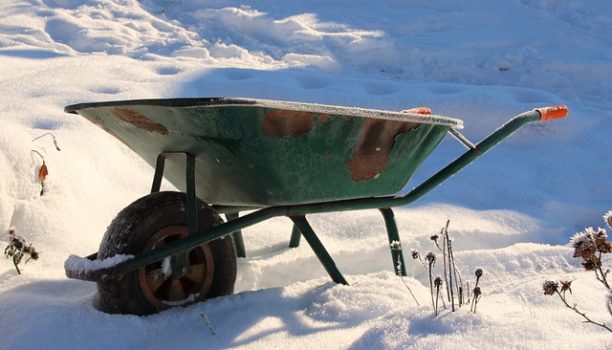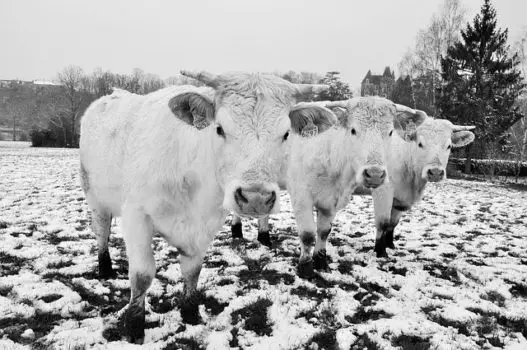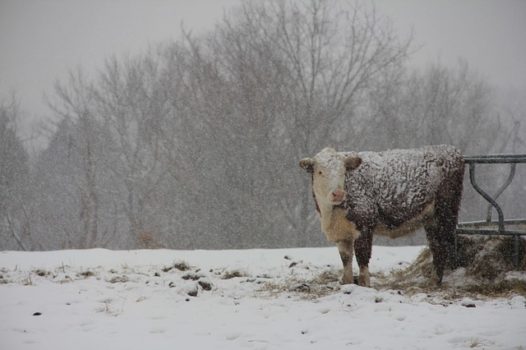Can I put animal manure on my garden in the winter?

During the winter season, animal pens and coops can become saturated with excess manure. The manure will need to be cleaned from the pens and coops, which raises the question of whether you can simply relocate it directly to your fields or gardens? The simple answer is yes, you can spread manure on your frozen cold ground, but to get the best results there are some things you will want to consider.
- The first Issue when spreading manure on frozen or snow-covered ground.
There are a few issues to consider when spreading animal manure on frozen and snow-covered ground. One is the problem of the manure moving from where you spread it to where it can end up as the ground thaws, or the snow melts.
With the thawing of frozen ground there shouldn’t be much movement of the manure. If you get no snow or rain, the manure should stay put. Though it will depend on the climate in which you live, here we will assume that your homestead or farm will receive some snow or rain throughout the winter.
When it rains and snows, the manure can be washed and pushed to the lowest elevated portion of the patch or be washed away. This will result in areas that will have a stronger concentration of manure and other areas with no manure. This can also happen if you live in an area of high wind, which can cause “drifting” or the accumulation of snow in specific areas. You won’t be able to have consistent coverage of the manure due to the run off of the snow melt and rain. The fertilization will be haphazard and you will need to keep a close watch on the plants. The plants may need additional side dressing of fertilizer as the season goes on. Other plants may have too high of a concentration of fertilizer and hamper growth.
Another problem with run off or drift accumulation is that your manure will lose its efficacy. Nitrates and other positive organic matter is washed away as the snow melts and runs off.
- The second issue is air and water pollution resulting from the off gassing and runoff of melted snow and rain.
If the manure is washed off with rain run-off or snow melt run-off, the manure can be washed into streams, rivers, ponds, or lakes. This can result in contamination of water and waterways. When manure contaminates water, it increases the number of nitrates in the water. This may result in health issues for young livestock and humans (particularly infants).
You may have noticed signage indicating warnings of “watershed” contamination on hiking trails forbidding dogs or other pets from usage. This is for the same reason. Any type of animal waste can cause major issues with water consumption and contamination.
- The third issue that can arise with spreading manure on frozen ground, or snow-covered ground.
One of the major benefits of putting manure on your gardens or fields comes from the nitrogen that is added to the soil. If you chose to spread your manure onto frozen snow or ice, it may remain exposed to air for longer periods of time as opposed to spring or summer broadcasting. By spreading the manure on frozen or snow-covered ground you begin the nitrogen utilization process.
Ammonium nitrogen is one type of nitrogen found in animal manure. Ammonium nitrogen will react or volatize as it is exposed to air. What this means is that the nitrogen will be lost into the air as ammonia gas. You may end up losing the nitrogen that you want in your soil, and actually be adding to air pollution levels as well.
One good thing about winter manure broadcasting is that the colder temperatures will slow down this reaction or volatization. So, you might be able to buy some time if you really need to get the manure out of the coop, pen, or stall if the temperature remains cold or freezing.
- A fourth issue to consider when spreading manure in the winter time effects the potency.
One of the most important reasons for adding manure to soil is an attempt to create “fixed” nitrogen (in other words, having the nitrogen transformed chemically in order to be beneficial to the plants in the soil). Frozen temperatures may retard or even eliminate the process by which nitrogen is made available for plant use.
Getting nitrogen “fixed” into the soil to be used by plants is part of the nitrogen cycle. In the nitrogen cycle bacteria is key. Different bacteria create the availability of nitrogen in the soil for plants to use. Some bacteria are found in the nodules of legume plant roots that will fix nitrogen into the soil. Other bacteria often found present in the soil itself, will work with the ammonium nitrogen in the manure to fix the nitrogen into the soil.
Still other environmental bacteria and fungi will participate in the decomposition process to fix nitrogen into soil. Bacteria has a vital role in the utilization of nitrogen from animal manure.
In frozen or snow-covered ground, the activity level of different bacteria can be paused, or slowed down. The slower reaction of the bacteria can also cause a reduction of the effectiveness of the nitrogen from the manure.
- A fifth problem with spreading manure on frozen or snow-covered ground is that it’s a mess and smells terrible.
I’ve had occasion to spread manure in the winter over snow-covered ground. It’s left an aroma that stenches the air for days on end. If the sun comes out and warms up the surface a little the stench is reignited for another round until the manure can get tilled in or if it freezes or snows again.
We have dogs. For some reason manure is an attractant to our K-9 friends. Our dogs will run, roll, and have a great time in the manure. This leaves us with a super smelly pet and member of the family. Often that means dog baths in the middle of winter.
If you have neighbors, they may complain. Some may even file a formal complaint to the city or governing body. You may get a warning or even a citation depending on city ordinances or Home Owners Association policies.
If you have a larger piece of ground you’re working, you’re probably out of town and it won’t matter that much. You probably will only need to worry about the loss of nutrients.

Storing manure might work better than spreading manure on frozen or snow-covered ground.
After looking into the different complications, you may decide that you would rather store the manure instead of spreading it all over frozen or snow-covered ground. Sometimes you need to clear out the manure from a coop, pen, or stall for the health of your animals.
One method of storage is just to stockpile the manure. You can just put it into a pile out of the way and wait until you have a good day to spread and plow in the manure. You need to plan for possible run-off from snow and run-off.
Another method of manure storage is to just put some bedding over the manure. This may work if you have enough space, and the health of the animals doesn’t become compromised. Sometimes the decomposition of the manure will create heat and can keep some animals warm throughout the colder months. Caution should be used if you are going to go with this deep pile method of just stacking up bedding on the manure. The same ammonia gas that helps with nitrogen fertilization can build up in coops, pens, and stalls. This can be really bad for your animals and may make them sick and even cause death.
Storage bins are another option. Sometimes you can create an area or bin for storing manure. On many farms there will be an area with a concrete pad with a wall or 3 sides to store manure in. It is a variation of the stockpile storage, but aids in containment. Smaller options can be crafted with pallets and tarps. Tarps spread out with some kind of structure, like a pallet or plywood can be a great option. If your tarp is large enough you can cove the manure pile.
One more method of storage can actually create an energy source. You can use an anaerobic digester. This basically holds the manure and captures the methane gas that comes off of the pile. The methane gas is flammable and can be controlled to burn as a fuel. There are many people who have made their own home-made digester, and there are some commercially available. Most anaerobic digesters are large and for use in industrial applications, but smaller home and backyard versions have been produced. This is an exciting option that I will look into and write an article about.
Summary of spreading manure on frozen or snow-covered ground.
The simple answer to the question, “Can I put manure on frozen or snow-covered ground?”. Is yes. If you need to get the manure out of your coop, pen, or stall, you can spread it on frozen or snow-covered ground.
You do need to consider what the pros and cons of that will be. The pro is that you get the manure out and it will fertilize you ground eventually. The cons of spreading manure on snow-covered or frozen ground are many. Including loss of nitrogen, creating air and water pollution, uneven distribution of fertilizer, and the smell and mess of having manure sitting on the surface until it can be tilled or plowed under.
There are various methods of storing the manure until it can be more easily handled. I would absolutely encourage anyone to look into storage before just spreading manure on frozen or snow-covered ground. I did work on a dairy farm for many years, and there were times that spreading manure was our only and best option. We did just fine, but with a little better planning, you can avoid being put into a bind where you don’t really have a choice.
You may want to also search for benefits of using manure as fertilizer, the nitrogen cycle, and pollution from manure.

